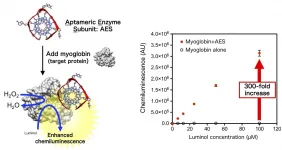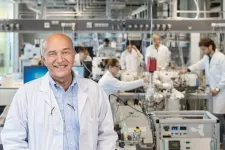(Press-News.org) A team of researchers from the University of Cambridge, University College London, University of Oxford, and University of Brescia/RFF-CMCC European Institute on Economics and the Environment carried out the first systematic analysis of the relative performance of probabilistic cost forecasts from expert-based methods and model-based methods.
They specifically focused on one expert-based method -- expert elicitations -- and four model-based methods which model costs either as a function of cumulative installed capacity or as a function of time. The results of this comparison are published in PNAS.
Accurately forecasting energy technology costs is a requirement for the design of robust and cost-effective decarbonization policies and business plans. The future of these and other technologies is notoriously hard to predict because the process by which technology is conceived, developed, codified, and deployed is part of a complex adaptive system and is made up of interconnected actors and institutions.
A range of probabilistic forecasting methods have been developed and used to generate estimates of future technology costs. Two high-level types of approaches have been most often used to generate quantitative forecasts: expert-based and model-based approaches. Broadly speaking, expert-based approaches involve different ways of obtaining information from knowledgeable individuals who may have differing opinions and/or knowledge about the relative importance of various drivers of innovation and how they may evolve. Experts make implicit judgments about the underlying drivers of change when producing their forecasts and can take into account both public information about observed costs as well as information that may not yet be widely available or codified. Expert-based approaches are often the only source of information available to analysts when data, on a given technology, has not yet been collected--as is generally the case for emerging technologies.
By contrast, model-based approaches explicitly use one or more variables from available observed data to approximate the impact of the full set of drivers of innovation on technology costs, implicitly assuming that the rate of change in the past will be the best predictor of the rate of change in the future.
"The increased availability of information on future energy technology costs allowed us to conduct the first systematic comparison of the relative performance of probabilistic technology cost forecasts generated by different expert-based and model-based methodologies with observed costs" notes senior and corresponding author Prof. Diaz Anadon, Professor of Climate Change Policy at the University of Cambridge and Director of the University's Centre for Environment, Energy and Natural Resource Governance. "Such a comparison is essential to ensure researchers and analysts have more empirically-grounded evidence in integrated assessment models, cost benefit analyses and broader policy design efforts". She suggests that undertaking this type of comparison to assess and better understand different forecasting methods should become more common among modellers and forecasting practitioners, as more data is available. "Our analysis is focused on a particular period of time and on correlated energy technologies, so although our results point to current methods underestimating technological progress in this space, more research is needed".
Prof. Anadon authored the article with Dr. Jing Meng, Lecturer at University College London at the Bartlett School, Dr. Rupert Way, postdoctoral researcher at the Oxford Martin School, and Prof. E. Verdolini from the Law Department of the University of Brescia and affiliated to the RFF-CMCC European Institute on Economics and the Environment. Prof. Anadon and Prof. Verdolini were Work Package Leaders in the EU H2020 project INNOPATHS, which funded the majority of the research work.
A number of key results emerge from this analysis.
As Dr. Way of the University of Oxford explains, "the comparison of expert- and model-based forecasts with observed 2019 costs over a short time frame (a maximum of 10 years) shows that model-based approaches outperformed expert elicitations. More specifically, the 5th-95th percentile range of the four model-based approaches were much more likely to contain the observed value than that of EE forecasts. Among the model-based methods, some captured 2019 observed costs more often than others".
"In addition", notes Dr. Meng from University College London "the 2019 medians of model-based forecasts were closer to the average observed 2019 cost for five out of the six technologies. However, this comparison was possible only for a small number of technologies; furthermore, some of the EE forecasts included the observed value". For these reasons, the authors argue, this should not be taken as evidence that model-based approaches perform better than expert-based methods for all or most cases.
Prof. Verdolini, from UniBrescia/EIEE points to the fact that both expert-based methods and model-based methods underestimated technological progress in most of the energy technologies analysed in this paper. "That is, in five out of six technologies analyzed, the methods produced 2019 cost forecast medians that were higher than the observed 2019 costs. This indicates that the rate of progress in cost reduction has been higher than what both historical data and expert opinions predicted. But the extent to which this faster pace of progress compared to forecasts will continue (or not) in the future remains to be seen".
The urgency of developing policies for deep decarbonisation, as outlined in the IPCC 1.5 C report, makes this systematic analysis timely and necessary. Taken together, results point to various worthwhile avenues for future research. Concerning expert elicitations, this paper calls attention to the need to continue methodological improvements to reduce overconfidence. For model-based methods, this work highlights the challenge of finding (and collecting) data for many key energy technologies. It also calls for increased efforts in data collection and publication by international organizations and other entities. The underestimation of technological progress also points to the value of further method development to reflect structural changes and technology correlations. Lastly, given the large uncertainty ranges and major policy decisions associated with the energy transition and with addressing climate change, additional research comparing the performance of different probabilistic forecasting approaches with observed values across a wider range of technologies should be carried out as more data becomes available and more time passes.
The article is complemented with a database containing a large number of data points on the costs of 32 energy technologies relevant to support the energy transition. These data points include 25 sets of data from expert elicitations conducted between 2007 and 2016 covering a range of geographies and 25 sets of observed technology data including the evolution of cost and deployment over different periods of time. This data was made publicly available here.
INFORMATION:
Researchers have developed a more efficient platform for studying proteins that play a key role in regulating gene expression. The approach uses engineered yeast cells to produce enzyme and histone proteins, conduct biochemical assays internally, and then display the results.
"Biomedical and biotech researchers are interested in the mechanisms that allow histones to regulate gene activity," says Alison Waldman, first author of a paper on the work and a Ph.D. student at North Carolina State University. "But the conventional tools for histone research are unwieldy ...
Mass-flowering crops such as oilseed rape or faba bean (also known as broad bean) provide valuable sources of food for bees, which, in turn, contribute to the pollination of both the crops and nearby wild plants when they visit. But not every arable crop that produces flowers is visited by the same bees. A team from the University of Göttingen and the Julius Kühn Institute (JKI) in Braunschweig has investigated how the habitat diversity of the agricultural landscape and the cultivation of different mass-flowering crops affect wild bees. The research shows that diverse agricultural landscapes increase the species richness ...
A team led by Skoltech professor Artem R. Oganov studied the structure and properties of ternary hydrides of lanthanum and yttrium and showed that alloying is an effective strategy for stabilizing otherwise unstable phases YH10 and LaH6, expected to be high-temperature superconductors. The research was published in the journal Materials Today.
Cuprates had long remained record-setters for high-temperature superconductivity until H3S was predicted in 2014. This unusual sulfur hydride was estimated to have high-temperature superconductivity at 191-204 K and was later obtained experimentally, setting a new record in superconductivity.
Following this discovery, many scientists turned to superhydrides, which are abnormally rich in hydrogen, and discovered new compounds that ...
Laboratories are an inherent part of technology qualifications, as practical experiments are essential for students to acquire the competencies and skills that they will need during their future professional development. Providing this learning in a virtual format is one of the challenges posed by the current COVID-19 pandemic--a challenge that distance universities have been addressing for years. RLAB-UOC is a remote laboratory designed and developed by the Universitat Oberta de Catalunya (UOC) that enables students in the Faculty of Computer Science, Multimedia and Telecommunications to conduct practical experiments with real electronic and communications equipment anywhere, at any time. A new article published in the scientific journal Electronics has described the characteristics ...
Near-death experiences are known from all parts of the world, various times and numerous cultural backgrounds. This universality suggests they may have a biological origin and purpose, but exactly what this could be has been largely unexplored.
A new study conducted jointly by the University of Copenhagen (Denmark) and the University of Liege (Belgium) and published in Brain Communications shows how near-death experiences in humans may have arisen from evolutionary mechanisms.
"Adhering to a preregistered protocol, we investigated the hypothesis that thanatosis is the evolutionary origin of near-death experiences", says Daniel Kondziella, a neurologist from Rigshospitalet, Copenhagen University Hospital.
When attacked by a predator, as a last resort defense mechanism, ...
An affordable lab system that uses grass blades to turn cells into cultured meat has been developed at the University of Bath in the UK.
Researchers have successfully taken grass from the university's campus and used it to create a scaffold that animal cells can attach to and grow on. The resulting tissue has the potential to be used both as lab-made meat and as human muscle tissue to repair or replace tissue which has been damaged or lost through injury or disease.
The study, by Dr Paul De Bank (Department of Pharmacy & Pharmacology), Professor Marianne Ellis (Department of Chemical Engineering) and Scott Allan (a PhD researcher in the Department of Chemical Engineering), is published in this month's Journal of ...
RUDN University chemists have proposed a new method of producing fuel from Jatropha Curcas, a poisonous tropical plant. Natural minerals and a non-toxic additive from vegetable raw materials are used for that. The reaction efficiency is 85%. The fuel can be used in diesel internal combustion engines. The results are published in the International Journal of Green Energy.
Jatropha Curcas is a common plant in many tropical regions. Its seeds contain lots of oil, but they cannot be used agriculture because the oil contains toxins that are dangerous for people and animals. But the composition of jatropha oil is suitable for the manufacture of biodiesel. One of challenge of the processing the plant raw materials is to select sufficiently ...
PROVIDENCE, R.I. [Brown University] -- Researchers from Brown University and MIT have developed a new data science framework that allows users to process data with the programming language Python -- without paying the "performance tax" normally associated with a user-friendly language.
The new framework, called Tuplex, is able to process data queries written in Python up to 90 times faster than industry-standard data systems like Apache Spark or Dask. The research team unveiled the system in research presented at SIGMOD 2021, a premier data processing conference, and have made the software freely available to all.
"Python is the primary programming language used by people doing data science," said Malte Schwarzkopf, an assistant professor of computer ...
A collaboration led by Distinguished Professor Dr. Kazunori Ikebukuro from Tokyo University of Agriculture and Technology (TUAT), Japan, discovered that G-quadruplex (G4)-forming DNA binds myoglobin through a parallel-type G4 structure. Through the G4 binding, the enzymatic activity of myoglobin increases over 300-fold compared to that of myoglobin alone (Figure). This finding indicates that DNA may work as a carrier of genetic information in living organisms and act as a regulator of unknown biological phenomena.
"Aptamers" are nucleic acid-based synthetic ligands that can be used against many target molecules with high affinity and specificity. Some aptamers that bind to proteins ...
Zeolites are extremely porous materials: Ten grams can have an internal surface area the size of a soccer field. Their cavities make them useful in catalyzing chemical reactions and thus saving energy. An international research team has now made new findings regarding the role of water molecules in these processes. One important application is the conversion of biomass into biofuel.
Fuel made from biomass is considered to be climate-neutral, although energy is still needed to produce it: The desired chemical reactions require high levels of temperature and pressure.
"If ...





